Climate Change and Polar Bears
A lot is being written and reported about the impact of climate change on polar bear populations.
While I can’t profess to have any depth of knowledge in this area, or indeed be in a position to substantiate the validity of what I am reading, I will attempt to sift through what I have read and present here what appears to me to make the best sense.
Polar Bear population
I’m going to start with some detail around polar bear populations. This is because each polar bear subpopulation is impacted by climate change differently.
On my trip hopefully I will see polar bears, and if I do, they are most likely to be in Svalbard. The polar bears there are part of the Barents Sea subpopulation (together with bears living in Norway and the western Russian Arctic).
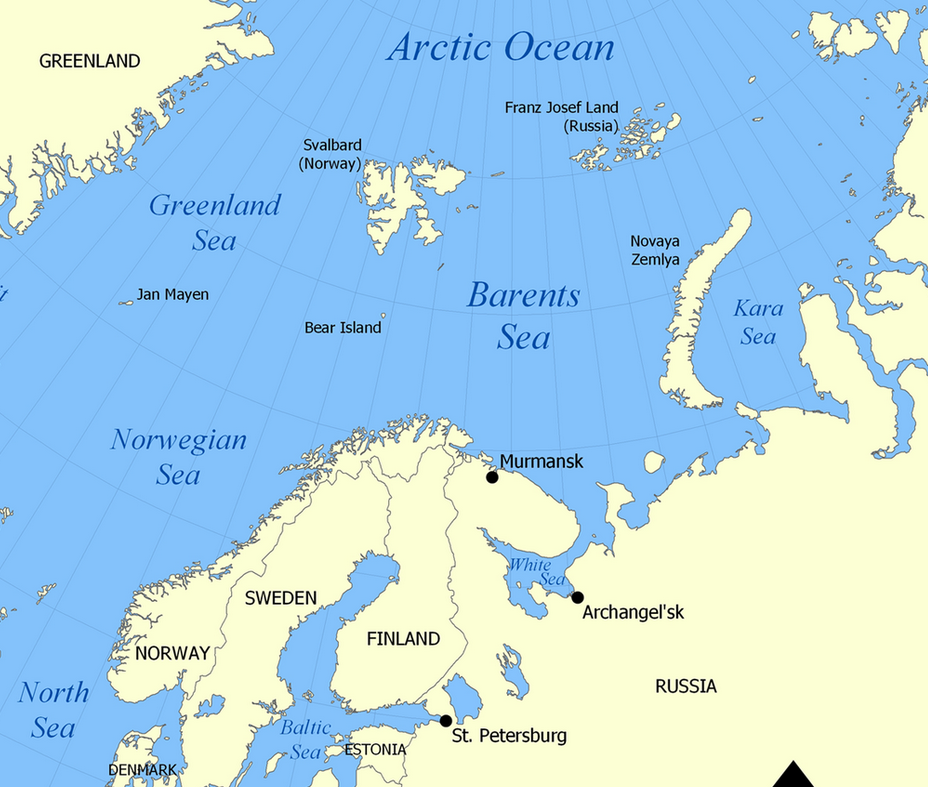
I found a lot on information on the Carbon Brief website, a UK-based website, funded by the European Climate Foundation, and covering the latest developments in climate science, climate policy and energy policy. In particular, I have referred to this article on their site.
Below is an image from the Carbon Brief site which shows information about the various subpopulations.
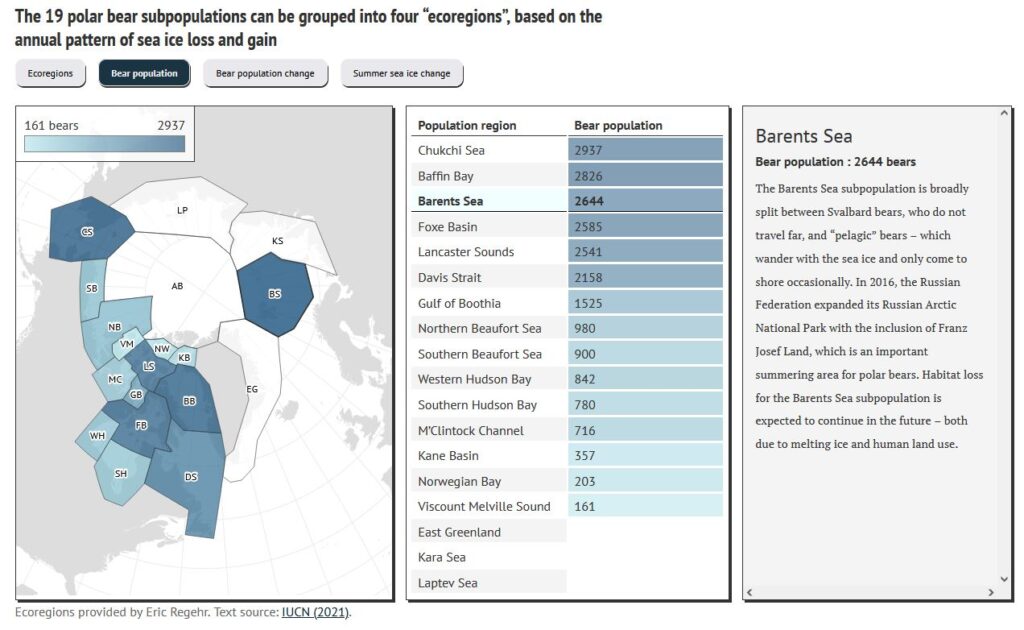
The Barents Sea group makes up roughly 10% of the world’s population of polar bears. It is thought that originally there were around 10,000 bears in this population, before extensive hunting from 1870 onward reduced the population. Of the total in the group, there are about 250 in Svalbard.
The Barents Sea bears have 2 different feeding strategies:
- The “coastal” bears stay near Svalbard and hunt seals close to shore on the ice fastened to the shore and on the glacial ice of the fjords. They hunt mostly in Spring. Coastal bears also eat reindeer, bird eggs and vegetation.
- The “pelagic” bears go out onto the ice pack, as it moves further out into the sea. They wander long distances and hunt over a much larger area. These polar bears will eat ringed seals, but also the larger bearded and harp seals.
Svalbard is one of the most concentrated denning areas for polar bears in the world. Dens are usually within 10 km of the coast, giving mothers and cubs easier hunting access to the ringed seals and their cubs. It is not until the cubs are older, that the pelagic bears venture out onto the sea ice.
Polar bears rely on sea ice
In 2016 a report was published by Royal Society which stated that the loss of sea ice is the greatest threat faced by polar bears.
The following extract from Carbon Brief site explains:
“The consensus is clear – as Arctic sea ice melts, polar bears are finding it harder to hunt, mate and breed. While polar bears have shown some ability to adapt to changes in their surroundings – for example, by foraging for food on land, or swimming more to hunt for prey – scientists project that as sea ice diminishes, polar bears will find it harder to survive and populations will decline.”
And, in case you need some more statements from respected organisations, following is a quote from the WWF website, which was the concluding paragraph in an article about reducing polar bear encounters in Greenland.
“Although it’s important to prevent conflicts between humans and polar bears in Arctic settlements, these efforts don’t address the real issue. The true threat to polar bears is the climate crisis, particularly the rapid loss of their sea ice habitat.”
Research is showing that polar bears are spending less time on sea ice and more time on land. Because the sea ice is where they hunt from, and because less sea ice can mean swimming for longer distances, this means that they are depleting their vital fat stores and/or fasting for longer periods, tending to weigh less, all of which lead to smaller numbers of offspring.
WWF assesses the vulnerability of species to the effects of climate change, and prepares a series of publications presenting their findings. You can download the full document here. At the end of the document they have published their rating of the climate vulnerability of the polar bear, according to a number of different factors. Out of the 19 individual factors or threats in total, 8 have been identified as factors which make polar bears highly vulnerable to climate change. As we would expect, one of these factors is Habitat Specialisation since polar bears “rely heavily on the sea ice environment for travelling, hunting, mating, resting , and in some areas, maternal dens.”
The WWF document includes the IUCN Red List Status of Polar Bears, which is “Vulnerable”. The International Union for Conservation of Nature was established in 1964 and publishes its Red List of Threatened Species. In 2019, a new assessment was released. The results can be summarised in the diagram below. There were only two populations where numbers were increasing. Of the remaining populations where data was available, half have stable populations and half have declining populations. Importantly, however, there are many subpopulations where information was not available.
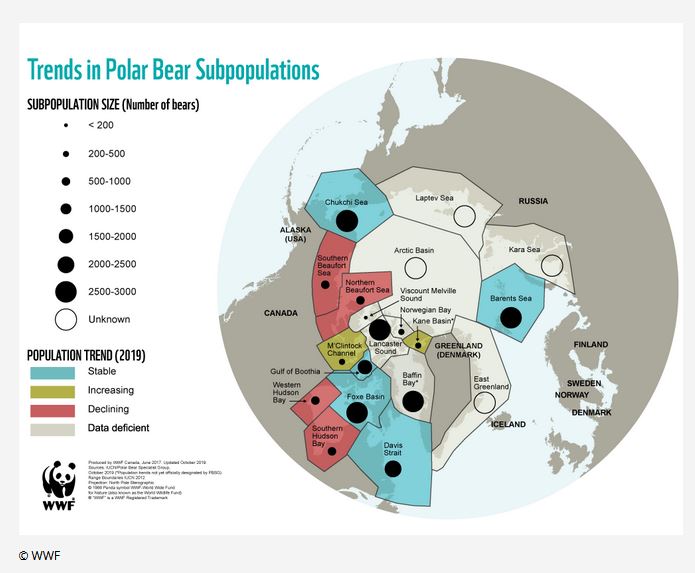
Sea ice …. what exactly is happening?
According to CarbonBrief the earth’s surface has warmed by around 1.2 degrees Celsius since the industrial revolution. However, temperatures in the Arctic are rising as much as 4 times faster than this global average. (If you want to read an article about why this is happening then following this link.)
Below are graphs which show the extent to which the Arctic sea ice has decreased:
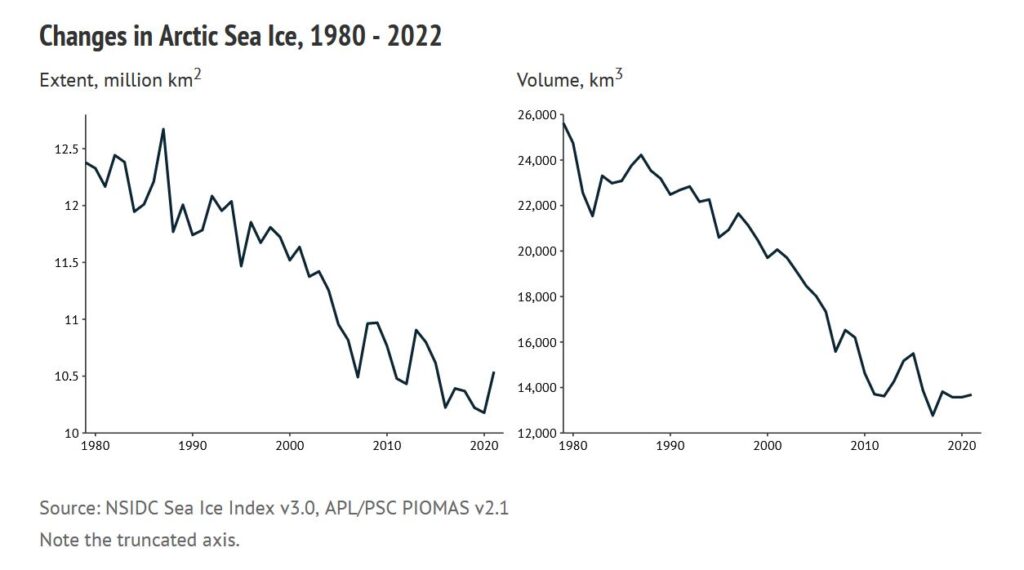
When you focus in on the impact on polar bears, all the polar bear subregions have experienced some loss of sea ice concentration with different rates in different areas, as can be seen by the following table
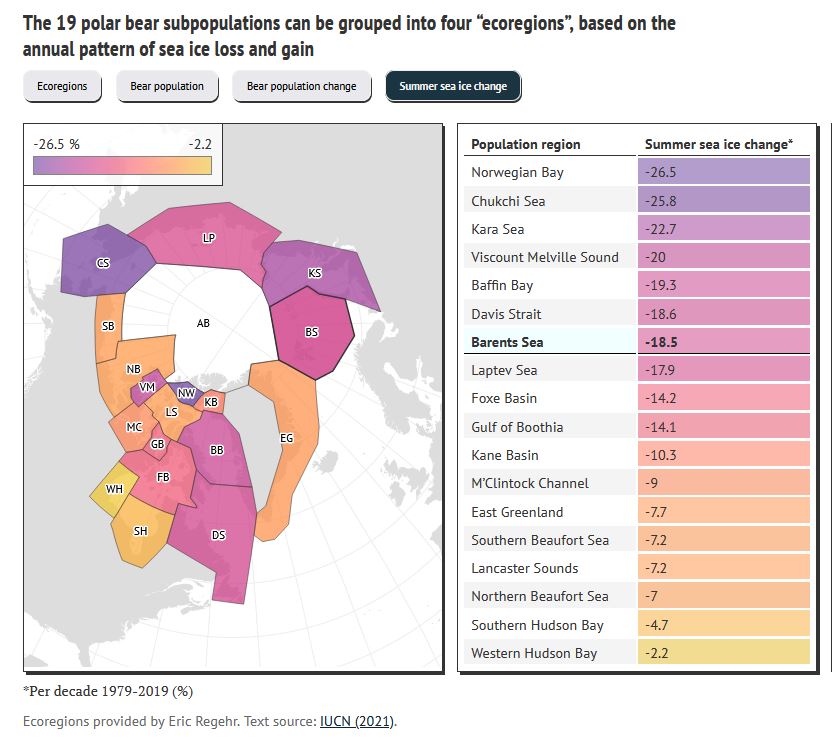
Furthermore, The Royal Society report identified that the Barent Sea subpopulation has been subjected to the greatest decline in the number of “sea ice” days, of 4.11 days per year. For every other subpopulation of bears, the decline in the number of “sea ice” days was less than 1.9 days.
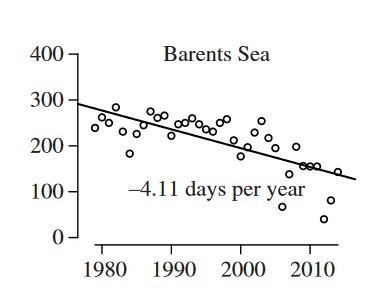
So, not only has the concentration of sea ice declined, but the number of days of sea ice coverage has declined.
These are all alarming statistics. And my biggest challenge in writing this blog was to decide which piece of shocking information I should include; they are all sobering.
Interaction between polar bears and humans
More often we are hearing reports of polar bears entering towns looking for food. All around the Arctic region polar bears are dealing with the decrease in sea ice by having to make choices about whether they stay on the ice and retreat with it further into the deep Arctic waters, or stay on the coast and face potential conflicts with humans.
In northeastern Russia, in the Chutokta region, residents of the coastal villages adjacent to Wrangel Island (a popular denning area, becoming known as the “polar bear maternity ward”) have had to establish polar bear patrols.
In Svalbard, you are required to carry some form of protection from polar bears (preferably a firearm) when you travel outside settlements.
In addition to conflicts which arise due to changing hunting habits by polar bears, I also want to just slip in here that in some areas humans are still allowed to hunt polar bears. Having said this, it is important to explain that, since 1973, when the Agreement on the Conservation of Polar Bears was signed, there has been a decrease in the number of polar bears hunted.
At the time of signing the Agreement, the biggest threat to polar bears was over-hunting. Consequently, Canada, Denmark, Norway, the US and Russia entered into the agreement thereby agreeing to undertake coordinated action to manage polar bear populations throughout the polar region. Since that time, they have “largely eliminated” the threat of overharvesting. The group continues to develop strategies for the ongoing preservation of polar bear populations.
For example, the Circumpolar Action Plan is a 10-year co-operation plan, adopted in 2015 between the members to “strengthen their efforts in polar bear conservation”. Seven objectives were identified which attempt to bring down to a level of influence, some of the threats which would otherwise appear to be global challenges. Below is an extract from the Polar Bear Range States website
The objectives are to:
- minimize threats to polar bears and their habitat
- communicate to the public, policy makers, and legislators around the world the importance of mitigating greenhouse gas emissions to polar bear conservation
- ensure the preservation and protection of essential habitat for polar bears
- ensure responsible harvest management systems today that will sustain polar bear subpopulations for future generations
- manage human-bear interactions to ensure human safety and to minimize polar bear injury or mortality
- ensure that international legal trade of polar bears is carried out according to conservation principles and that poaching and illegal trade are curtailed.
- carry out coordinated circumpolar population research and monitoring to monitor progress toward achieving the vision of the CAP
So, where does this leave us?
Well, no matter how much data is collected about polar bear populations, or how many goals are set and action plans articulated around bear conservation, it all appears to point to the sea ice and the impact on it of climate change. And regardless of where you stand about what has caused climate change, it is definitely up to us to do something about it.
I’d like to finish with a quote from Barry Lopez in “Arctic Dreams”:
“We have been telling ourselves the story of what we represent in the land for 40,000 years. At the heart of this story, I think, is a simple, abiding belief: it is possible to live wisely on the land, and to live well. And in behaving respectfully toward all that the land contains, it is possible to imagine a stifling ignorance falling away from us.”
One thought on “Climate Change and Polar Bears”
It is difficult to understand what we can do as individuals as every aspect of consumerism relates back to global warming. There are too many of us and our population is increasing, unchecked, with increased desires for word travel, non seasonal diets and home comforts. The pandemic did more to address the problem than anything else I have seen, food for thought 🤔
Comments are closed.